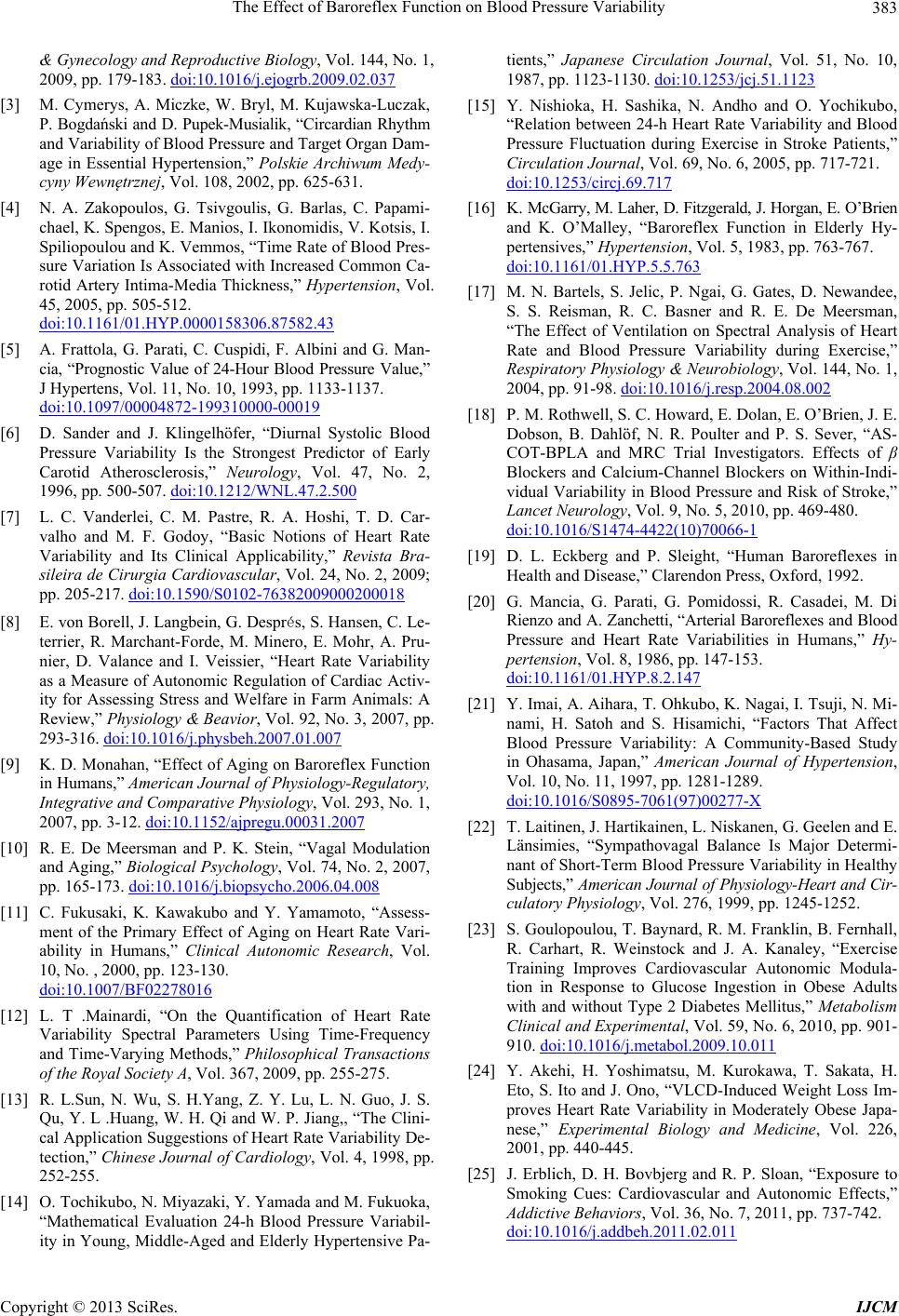
The Effect of Baroreflex Function on Blood Pressure Variability 383
& Gynecology and Reproductive Biology, Vol. 144, No. 1,
2009, pp. 179-183. doi:10.1016/j.ejogrb.2009.02.037
[3] M. Cymerys, A. Miczke, W. Bryl, M. Kujawska-Luczak,
P. Bogdański and D. Pupek-Musialik, “Circardian Rhythm
and Variability of Blood Pressure and Target Organ Dam-
age in Essential Hypertension,” Polskie Archiwum Medy-
cyny Wewnętrznej, Vol. 108, 2002, pp. 625-631.
[4] N. A. Zakopoulos, G. Tsivgoulis, G. Barlas, C. Papami-
chael, K. Spengos, E. Manios, I. Ikonomidis, V. Kotsis, I.
Spiliopoulou and K. Vemmos, “Time Rate of Blood Pres-
sure Variation Is Associated with Increased Common Ca-
rotid Artery Intima-Media Thickness,” Hypertension, Vol.
45, 2005, pp. 505-512.
doi:10.1161/01.HYP.0000158306.87582.43
[5] A. Frattola, G. Parati, C. Cuspidi, F. Albini and G. Man-
cia, “Prognostic Value of 24-Hour Blood Pressure Value,”
J Hypertens, Vol. 11, No. 10, 1993, pp. 1133-1137.
doi:10.1097/00004872-199310000-00019
[6] D. Sander and J. Klingelhöfer, “Diurnal Systolic Blood
Pressure Variability Is the Strongest Predictor of Early
Carotid Atherosclerosis,” Neurology, Vol. 47, No. 2,
1996, pp. 500-507. doi:10.1212/WNL.47.2.500
[7] L. C. Vanderlei, C. M. Pastre, R. A. Hoshi, T. D. Car-
valho and M. F. Godoy, “Basic Notions of Heart Rate
Variability and Its Clinical Applicability,” Revista Bra-
sileira de Cirurgia Cardiovascular, Vol. 24, No. 2, 2009;
pp. 205-217. doi:10.1590/S0102-76382009000200018
[8] E. von Borell, J. Langbein, G. Després, S. Hansen, C. Le-
terrier, R. Marchant-Forde, M. Minero, E. Mohr, A. Pru-
nier, D. Valance and I. Veissier, “Heart Rate Variability
as a Measure of Autonomic Regulation of Cardiac Activ-
ity for Assessing Stress and Welfare in Farm Animals: A
Review,” Physiology & Beavior, Vol. 92, No. 3, 2007, pp.
293-316. doi:10.1016/j.physbeh.2007.01.007
[9] K. D. Monahan, “Effect of Aging on Baroreflex Function
in Humans,” American Journal of Physiology-Regulatory,
Integrative and Comparative Physiology, Vol. 293, No. 1,
2007, pp. 3-12. doi:10.1152/ajpregu.00031.2007
[10] R. E. De Meersman and P. K. Stein, “Vagal Modulation
and Aging,” Biological Psychology, Vol. 74, No. 2, 2007,
pp. 165-173. doi:10.1016/j.biopsycho.2006.04.008
[11] C. Fukusaki, K. Kawakubo and Y. Yamamoto, “Assess-
ment of the Primary Effect of Aging on Heart Rate Vari-
ability in Humans,” Clinical Autonomic Research, Vol.
10, No. , 2000, pp. 123-130.
doi:10.1007/BF02278016
[12] L. T .Mainardi, “On the Quantification of Heart Rate
Variability Spectral Parameters Using Time-Frequency
and Time-Varying Methods,” Philosophical Transactions
of the Royal Society A, Vol. 367, 2009, pp. 255-275.
[13] R. L.Sun, N. Wu, S. H.Yang, Z. Y. Lu, L. N. Guo, J. S.
Qu, Y. L .Huang, W. H. Qi and W. P. Jiang,, “The Clini-
cal Application Suggestions of Heart Rate Variability De-
tection,” Chinese Journal of Cardiology, Vol. 4, 1998, pp.
252-255.
[14] O. Tochikubo, N. Miyazaki, Y. Yamada and M. Fukuoka,
“Mathematical Evaluation 24-h Blood Pressure Variabil-
ity in Young, Middle-Aged and Elderly Hypertensive Pa-
tients,” Japanese Circulation Journal, Vol. 51, No. 10,
1987, pp. 1123-1130. doi:10.1253/jcj.51.1123
[15] Y. Nishioka, H. Sashika, N. Andho and O. Yochikubo,
“Relation between 24-h Heart Rate Variability and Blood
Pressure Fluctuation during Exercise in Stroke Patients,”
Circulation Journal, Vol. 69, No. 6, 2005, pp. 717-721.
doi:10.1253/circj.69.717
[16] K. McGarry, M. Laher, D. Fitzgerald, J. Horgan, E. O’Brien
and K. O’Malley, “Baroreflex Function in Elderly Hy-
pertensives,” Hypertension, Vol. 5, 1983, pp. 763-767.
doi:10.1161/01.HYP.5.5.763
[17] M. N. Bartels, S. Jelic, P. Ngai, G. Gates, D. Newandee,
S. S. Reisman, R. C. Basner and R. E. De Meersman,
“The Effect of Ventilation on Spectral Analysis of Heart
Rate and Blood Pressure Variability during Exercise,”
Respiratory Physiology & Neurobiology, Vol. 144, No. 1,
2004, pp. 91-98. doi:10.1016/j.resp.2004.08.002
[18] P. M. Rothwell, S. C. Howard, E. Dolan, E. O’Brien, J. E.
Dobson, B. Dahlöf, N. R. Poulter and P. S. Sever, “AS-
COT-BPLA and MRC Trial Investigators. Effects of β
Blockers and Calcium-Channel Blockers on Within-Indi-
vidual Variability in Blood Pressure and Risk of Stroke,”
Lancet Neurology, Vol. 9, No. 5, 2010, pp. 469-480.
doi:10.1016/S1474-4422(10)70066-1
[19] D. L. Eckberg and P. Sleight, “Human Baroreflexes in
Health and Disease,” Clarendon Press, Oxford, 1992.
[20] G. Mancia, G. Parati, G. Pomidossi, R. Casadei, M. Di
Rienzo and A. Zanchetti, “Arterial Baroreflexes and Blood
Pressure and Heart Rate Variabilities in Humans,” Hy-
pertension, Vol. 8, 1986, pp. 147-153.
doi:10.1161/01.HYP.8.2.147
[21] Y. Imai, A. Aihara, T. Ohkubo, K. Nagai, I. Tsuji, N. Mi-
nami, H. Satoh and S. Hisamichi, “Factors That Affect
Blood Pressure Variability: A Community-Based Study
in Ohasama, Japan,” American Journal of Hypertension,
Vol. 10, No. 11, 1997, pp. 1281-1289.
doi:10.1016/S0895-7061(97)00277-X
[22] T. Laitinen, J. Hartikainen, L. Niskanen, G. Geelen and E.
Länsimies, “Sympathovagal Balance Is Major Determi-
nant of Short-Term Blood Pressure Variability in Healthy
Subjects,” American Journal of Physiology-Heart and Cir-
culatory Physiology, Vol. 276, 1999, pp. 1245-1252.
[23] S. Goulopoulou, T. Baynard, R. M. Franklin, B. Fernhall,
R. Carhart, R. Weinstock and J. A. Kanaley, “Exercise
Training Improves Cardiovascular Autonomic Modula-
tion in Response to Glucose Ingestion in Obese Adults
with and without Type 2 Diabetes Mellitus,” Metabolism
Clinical and Experimental, Vol. 59, No. 6, 2010, pp. 901-
910. doi:10.1016/j.metabol.2009.10.011
[24] Y. Akehi, H. Yoshimatsu, M. Kurokawa, T. Sakata, H.
Eto, S. Ito and J. Ono, “VLCD-Induced Weight Loss Im-
proves Heart Rate Variability in Moderately Obese Japa-
nese,” Experimental Biology and Medicine, Vol. 226,
2001, pp. 440-445.
[25] J. Erblich, D. H. Bovbjerg and R. P. Sloan, “Exposure to
Smoking Cues: Cardiovascular and Autonomic Effects,”
Addictive Behaviors, Vol. 36, No. 7, 2011, pp. 737-742.
doi:10.1016/j.addbeh.2011.02.011
Copyright © 2013 SciRes. IJCM